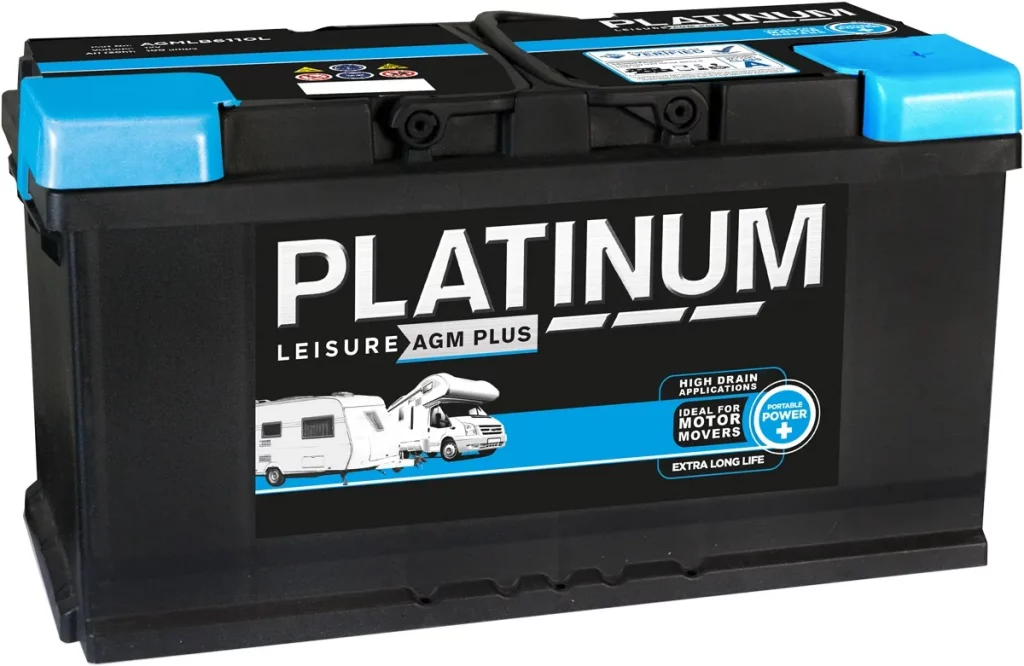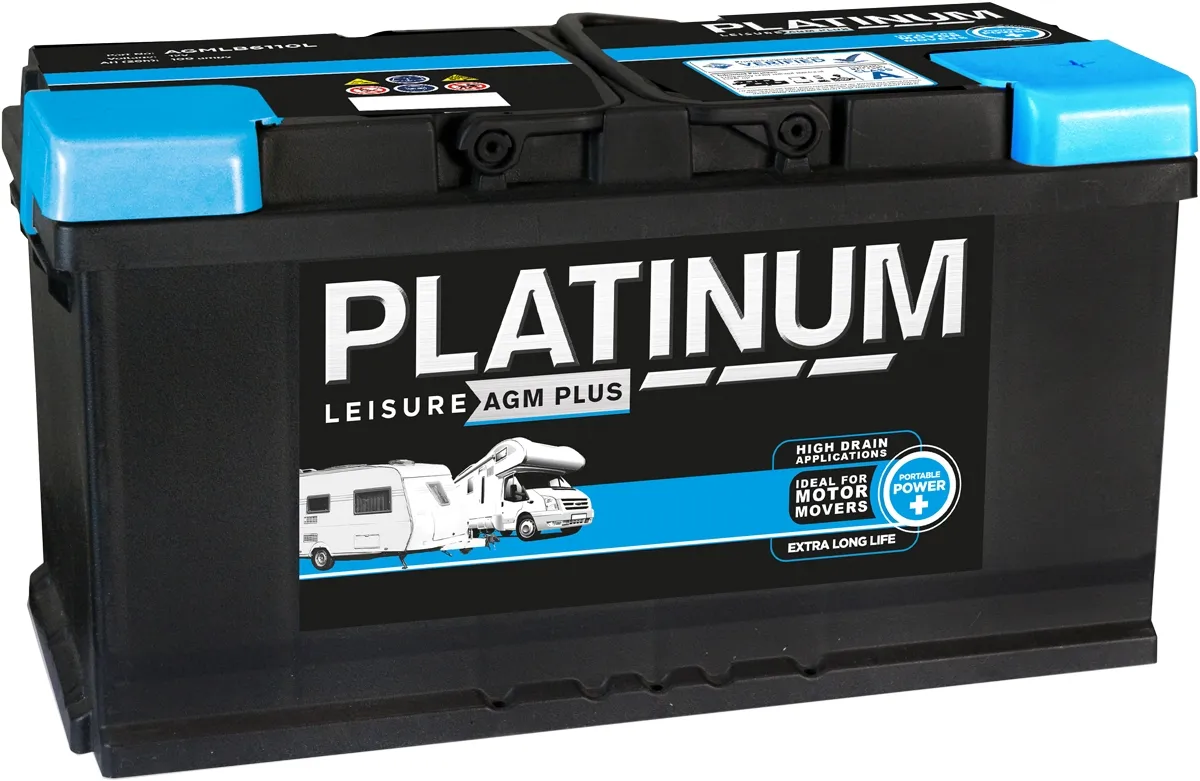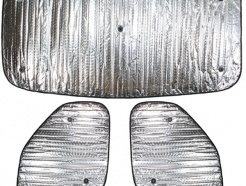PLATINUM AGM PLUS LEISURE BATTERY 12V 100AH AGMLB6110L
£183.60
Description
PLATINUM AGM PLUS LEISURE BATTERY 12V 100AH AGMLB6110L

The Platinum Leisure Battery range offers power and service life for any budget.
The Platinum range has very strong deep cycle capabilities thanks to the thick plate construction inside. This also helps improve the life of the battery and gives added resistance to shocks and vibrations.
The Platinum range is perfect for 2-4 berth leisure vehicles, particularly on weekend vacations.
Whether AGM batteries compared to their flooded counterparts are better or not is one of the most common questions about car batteries. There are some uses of products developed on lithium for batteries, however, the vast majority of such products that vehicles use are either flooded or simply, AGM lead-acid batteries. For some people, it is possible to mix up between gel and AGM batteries in case of automotive applications, but they have very different technologies.
AGM Batteries are known as the technology marvel for its lead-acid battery system. Being the peak of engineering, they are a perfect bridge to the transition of the world into lithium-ion. And with that reputation, AGM tends to offer way more than what gel batteries have to offer.
The Science of AGM (Absorbed Glass Mat) Battery Type
AGM (or Absorbed Glass Mat) batteries are spill-proof lead-acid batteries with very low internal resistance. The glass mat is specially made up of thin glass fibers soaked in the solution of sulfuric acid. They are directed in between the plates of the battery so electrolytes are absorbed. The battery plates are made of lead which expresses the sandwich construction to be vibration resistance. With the aim of high electrical reliability achievement, AGM batteries are designed to have specific power which makes it very responsive to the load. They are lighter, maintenance-free, have a low self-discharge of 80% DoD and delivers 5 times faster charge with high currents on demand than with flood technology. They can be deep-cycled and have a long cycle of life as it can resist low temperatures.
Why AGM Batteries are Better
Due to the same deep-cycle process, gel batteries and AGM batteries often seem confusing. They both are called Valve Regulated Lead-Acid batteries where the negative plate absorbs the oxygen produced on the positive plates of lead-acid batteries and creates water. It reduces the step of watering the batteries making it maintenance-free. Moreover, silica gels in gel batteries substitute glass mat for holding the electrolytes while making the electrons to free flow. They lose power faster especially at lower temperatures than the AGM batteries because of the gelled composition. For AGM batteries, glass mats can work in any temperature, have high-level usage, and are cheaper with longer life span.
Flooded lead-acid batteries are cheaper than AGM batteries but they are not long-lasting. It is the mainstream battery type that inputs a combination of liquid electrolytes. Battery plates in the Flooded Lead-acid batteries are submerged fully and creates oxygen and hydrogen gases. Water is chemically broken down in the battery so they often require replacement of water. The acid (liquid electrolyte) inspection must be regularly done where a professional should measure it. High/cold temperatures input a shock on the performance as the electrolytes are caused to accordingly be evaporating/freezing.
Brand PlatinumProduct
CodeAGMLB6110L
Voltage 12 VoltsTechnologyAGMCapacity (C20)100 Ah
Length354 mmWidth175 mm Height inc. terms190 mm
NCC ClassA Guarantee2 Years
Barcode (EAN)5060043804190
BATTERY WARRANTY INFORMATION
While all of our batteries come with warranty, this can vary from 12 months up to 5 years.
What’s covered under the Warranty?
This is fairly simple – the warranty on your battery covers all faults caused by manufacturing workmanship or materials.
What’s NOT covered under the Warranty?
The warranty does not cover the following:
- Sulphation
- Wear and Tear
- Deep or Over Cycling
- Overcharging
- Physical Damage
- Incorrect Application
Fault Diagnosis
All batteries once filled with electrolyte become active, and will slowly self-discharge. The higher the temperature that they are stored at, the higher this self discharge rate will be.
It is important that no battery is allowed to discharge to the point of sulphating (12.06v), or so that they are no longer able to start the car/bike/truck or operate the required equipment. To prevent this we recommend monthly voltage checks, especially on vehicles that are used infrequently, or stand by equipment.
Once a battery’s voltage drops to 12.4v, we recommend that it is then recharged at a rate of around 10% of the battery’s capacity for 10 hours or until it has a voltage at rest of at least 12.65V.
Non-Manufacturing Faults
The warranty does not covered faults that are not due to a manufacturing issue. Examples of non-manufacturing faults are described below.
Sulphation
Sulphation occurs when a battery is allowed to stand in a discharged state for an excessive amount of time. When a battery voltage drops below a certain level, a chemical reaction known as sulphation takes place. In most cases this voltage is at or below 12.06v. Sulphation is normally irreversible, and can permanently impair performance of the battery, causing reduced performance and premature failure. Sulphation can be seen as a fine white/grey coating on the plates.
This damage can be caused if a battery is stored for long periods without charging, or installed in applications that are not frequently used, i.e. tractors, boats and motorbikes. Vehicles are prone to discharging batteries as there is always a permanent drain form vehicle clock, alarms etc. Over time, sulphation will build up on the plates, and hinder the performance of the battery.
It is worth noting that under normal operating conditions a battery cannot become discharged on its own (unless left for a long period of self-discharge). The reason for this discharge is normally caused by one of the following; malfunctioning alternator, regulator, or starter motor, slipping fan belt, electrical fault, excessive use of electrical items such as heated seats, air conditioning etc, long standing time without recharge, boot light/glove box malfunction, vehicle lights being left on, etc./p>
As sulphation is easily avoided by simply keeping your battery charged, this is a non-manufacturing fault.
Wear and Tear, and Deep Cycling
When a battery is charged and discharged, material from the battery plates (active mass) is in motion, through the electromechanical reaction that produces electricity. Every time a battery goes through a charge-discharge cycle, a small amount of this active mass is lost from the plates. Due to so many factors impacting on the life of a battery, it is impossible to stipulate a minimum or maximum life expectancy.
Every battery has a finite number of cycles that it can go through before it loses its active mass, and in turn, its capacity. Vehicles with high usage, such as busses, taxis and trucks, will often put a battery through this finite number of cycles over a much shorter amount of time, causing a battery to show the above symptoms after only a couple of years. This is not a manufacturing fault.
When a battery is subject to a deep discharge, and/or a rapid rate of recharge, the above process is accelerated. A battery that is deep discharged regularly, or is often discharged blow 50% (12.1v) in the case of leisure batteries, will rapidly lose its active mass, and capacity. An example of this is the use of a leisure battery for running window cleaning water pumps. The loss of active mass, and therefore capacity due to over/excessive cycling is not a manufacturing fault.
Overcharging
If a battery is charged at an excessive voltage or current, it can overheat, and the electrolyte will start to evaporate. Overcharging will cause the active mass in the plates of the battery to rapidly breakup, and battery performance will be permanently affected, as will the cyclic life of the battery.
This is normally quite obvious to spot when examining the battery. During charging, there may be a pungent smell of rotting eggs. When off charge, the battery will have low levels of acid, and there may be a black coating on the filler caps (It is not possible to check the levels or maintenance free batteries). This is not a manufacturing fault.
Physical damage
Any physical damage that occurs to the battery terminals or casing due to improper fitment, if the battery is dropped, if any connectors are hammered on to the terminals, or if connectors are not properly fastened, the battery may fail rapidly. This is not a manufacturing fault.
Incorrect application
Fitting a smaller or less powerful battery, or the incorrect type of battery for the application will result in shortened lifespan and premature failure. This is not a manufacturing fault.
Provided that the correct battery has been selected for the correct application or vehicle, instances of manufacturing faults will be minimum.
HOW TO CARE FOR YOUR BATTERY – MAINTAINING YOUR WARRANTY
This information has been published on the website to help our customers get the maximum service life and performance from their batteries. This information will help our customers get the most from their battery and keep it in optimum health. By following the guide below, the only way your battery will fail is from old age, a manufacturing fault or from physical damage.
Best Practice
1. Never leave your battery in a discharged state
When a battery has been fully charged it can quite happily be stored away for 2-3 months. However when a battery is flat, storing it for this period would almost certainly damage it beyond repair.
The reason behind this is a chemical process called sulphation. When a battery is charged this chemical process cannot take place. However, when the battery’s voltage falls below 12.4V this process begins. The process causes sulphur crystals to form on the lead plates inside the battery, which in turn increases the battery’s electrical resistance. The longer this process is allowed to continue the worse the effect. Eventually the battery will become so electrically resistant, that you will be unable to charge the battery, let alone draw power from it.
If this process is caught early you may be able to salvage the battery using a battery charger with a pulse charge function. This will partially break down the sulphur crystals but the battery will never reach its full capacity again.
Remember that if your battery fails due to sulphation it will not be covered under warranty. This kind of failure is classed as damage caused by the user through neglect.
2. Never overcharge your battery
Although you must always keep your battery as charged as possible when not in use, you must never overcharge it. Overcharging will cause the battery to heat up and its electrolyte will start to evaporate. In turn this will cause the battery’s plates to break down, severely reducing the battery’s ability to yield power.
Overcharging can be caused by a faulty regulator on a vehicle’s charging system or by a manual charger being left on continuously at a high charging rate.
Fortunately, most chargers these days are now automatic and will turn themselves off once the battery has reached the end of a charging cycle.
This type of damage is also not covered under warranty, as the battery is clearly not at fault.
3. Avoid deep discharging when possible
Everybody knows that all batteries will deteriorate over time, and will eventually have to be replaced. Every time you use your battery then recharge it, its performance is ever so slightly decreased. This cannot be avoided. However, the severity of this decrement can be limited.
The way to achieve this is to not discharge your battery too deeply. Deep discharging causes the performance decrement to be more severe. Therefore once you have used the battery for the day, it is best to recharge rather than use it until it becomes flat.
Obviously, in the real world this is not always possible as the battery may be fully drained with one days use. But when you can, recharge the battery before it’s fully discharged.
Preparation Checks
Before you plan to use your battery, you should always follow the steps below to make sure it’s ready for use.
1. Give your battery a top-up charge
As we know from above, you should have stored your battery in a charged state to avoid sulphation. However, even though the battery will be charged you should always perform a top up charge before touring. This will ensure the battery is in peak condition.
2. Check the electrolyte levels in your battery
Most batteries these days are the sealed, maintenance-free type, but there are still a few open vent batteries on the market. If you have one of these you should always check the battery levels before touring. The level of the electrolyte should be just above the battery plates, ensuring the whole plate is submerged. Any part of the plate, which is not submerged, is prone to break down. This in turn will decrease the performance of the battery.
If you need to top up the battery levels, make sure you only use de-ionised water. Using tap water will cause mineral build up on the plates and reduce the performance of the battery.
For those of you with sealed, maintenance-free batteries this is not a concern, as they are designed to retain their electrolyte under normal conditions. The only way these batteries will have low electrolyte levels is if the battery is overcharged or a particular cell becomes faulty, causing over heating.





